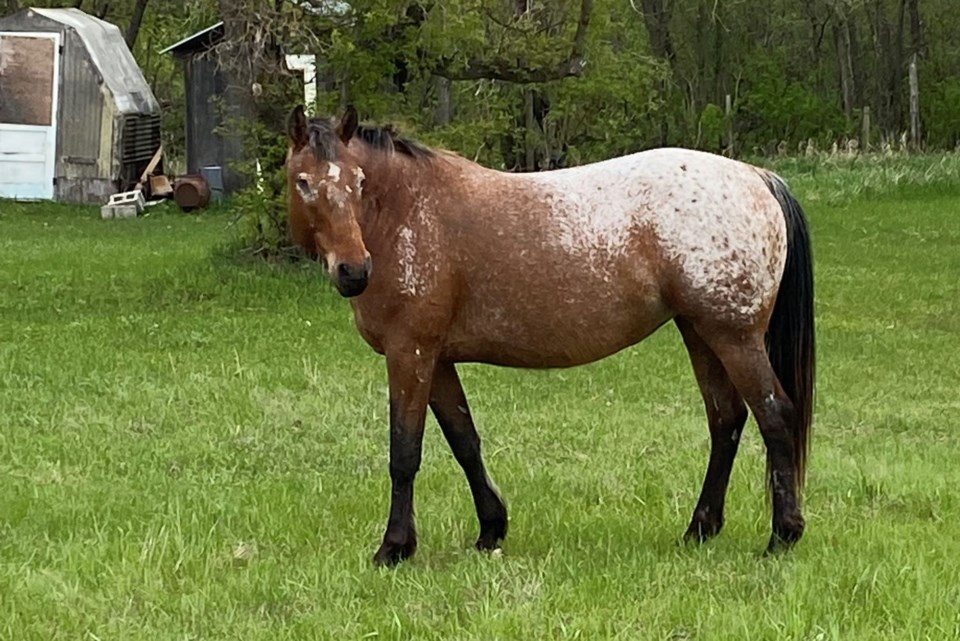STOUGHTON - Equine recurrent uveitis (ERU) is an incurable eye disease in horses of all ages and breeds. It is also referred to as moon blindness.
In 2017, I purchased an eight-year-old Arabian appaloosa-cross mare. She was bred for her great temperament and confirmation. She is an exceptionally well broke and kind horse, the reason I made her mine.
Misty, as we call her, has been ridden by children as young as five years old. She joined the horse club at an early age and soon became one of the lesson horses.
In January of 2018, we noticed her eye was red and swollen. It was tearing and she was squinting like the sun was too bright. I thought it was a poke to the eye with a piece of hay or a branch. Sadly, that would not be the cause.
After two days of the eye remaining the same, Dr. Ann Y. Kernaleguen was called from the Stoughton Veterinary Services. She came out the same day to conduct an exam. I was told eyes are emergencies.
Misty was a very co-operative patient, according to Kernaleguen. We needed to rule out things like trauma, ulcers and infection through a test called fluorescent stain. This stain turns bright green when these issues are detected in the eye. This was not the case, so onto the next test.
An eye pressure test was next in line, called a tonometer. Horses eye pressure should read between 10 and 21 millimetres of mercury (mm). Misty’s reading was a whopping 56 mm. This was not what I was hoping for, and it was confirmed by Kernaleguen that my horse had ERU.
At the time, I knew little to nothing about this equine recurrent uveitis. My research began, with calls to veterinarians in different areas. I was looking for any information that could help with Misty’s eye. Kernaleguen was involved with Misty on a regular basis, up to almost weekly visits. We knew we had a long road ahead of us.
ERU causes inflammation to the eye. It can be a one-time occurrence or at intervals throughout the year. Others can be controlled with medication and others not. It is a progressive condition, which is very painful.
Medicated drops were prescribed. At first, one kind was administered twice daily. It did not work. Another drop was then used along with it. We still had no luck at getting the flareups under control. Once again Kernaleguen returned to check Misty’s eye pressure. It remained unchanged.
Another medicated drop was tried. This was over the course of four months. Now the ultimate goal was to control her pain and reduce inflammation, if this was even possible.
There are horses that do very well with allowing drops in their eyes. Misty was a rock star. In the middle of the field with no halter, the drops could be put in. A horse’s eye lid is one of their strongest muscles.
Other horses become upset when working with the eyes. At this point a port is attached to the mane with a long tube and inserted through the eye lid. Medication can then be injected through the port for effortless application. This is called a sub palpebral Laval catheter. This method was offered to me, but it was not needed.
Appaloosas are eight times more likely to contract this awful disease. It is believed to be genetic, although the environment can play a key role. This painful disease is also the No. 1 cause of blindness in horses.
We were losing the battle and it was then that Kernaleguen suggested our last resort, which was the enucleation of the eye. Once again, I was not prepared to hear this. It was at this point that Kernaleguen referred us to the Sherwood Animal Clinic in Regina. Dr. Stewart took on Misty’s case.
Arriving at the clinic in Regina, once again Misty’s eye was stained, and pressure was taken. It was at that time I was told Misty no longer had sight in her eye. Her eye had turned cloudy over the months, but I was still hoping there was something else that could be done.
Stewart gave me all the details of an enucleation. I deliberated over this, and the decision was made to remove the eye. She could not see out of it, and it caused her a great deal of pain. The surgery went well, and she went home the same day. Stewart said the eye was slightly enlarged, but everything was okay.
Kernaleguen took over once again. Stitches were removed at 14 days and life would begin with one eye. I have been extremely fortunate to have excellent caring vets to help me through this journey. One would never know she cannot see on her right side unless you walk beside her and see the eyeless socket. She is the same horse as before.
According to Stewart, Misty should wear a fly mask with UV protection. Nutrition is always important with excellent quality hay, and vitamin A for the eyes.
Misty has a yearly checkup through Kernaleguen. I have learned that eyes are definitely an emergency. We will continue to enjoy life on the trails or doing barrels.





